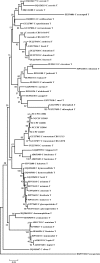Colletotrichum truncatum: an unusual pathogen causing mycotic keratitis and endophthalmitis
- PMID: 21653772
- PMCID: PMC3147767
- DOI: 10.1128/JCM.00151-11
Colletotrichum truncatum: an unusual pathogen causing mycotic keratitis and endophthalmitis
Abstract
In recent years, the well-known plant pathogens of the Colletotrichum genus were increasingly reported to cause ophthalmic infections in humans. Among 66 species in the Colletotrichum genus, only a few are known to be pathogenic for humans. We report here five cases of ophthalmic infections due to Colletotrichum truncatum, a species never reported earlier to cause human infection. The isolates were identified by morphological characteristics and the sequencing of internal spacer regions of ribosomal DNA. The progress of lesions in those patients was slow compared to that of lesions caused by Aspergillus or Fusarium infections. The surgical management included total penetrating keratoplasty in patients with keratitis and pars plana vitrectomy in endophthalmitis. Two patients were treated additionally with intravitreal amphotericin B deoxycholate, one patient with oral itraconazole, and another patient with oral and topical fluconazole therapy. The present series therefore highlights the expanding spectrum of agents causing eye infections and the inclusion of C. truncatum as a human pathogen.
Figures


References
-
- Berger S. T., Katsev D. A., Mondino B. J., Pettit T. H. 1991. Macroscopic pigmentation in a dematiaceous fungal keratitis. Cornea 10: 272–276 - PubMed
-
- Cai L., et al. 2009. A polyphasic approach for studying Colletotrichum. Fungal Divers. 39: 183–204
-
- Cannon P. F., Buddie A. G., Bridge P. D. 2008. The typification of Colletotrichum gloeosporioides. Mycotaxon 104: 189–204
-
- Chakrabarti A., et al. 2008. Fungal endophthalmitis: fourteen years' experience from a centre in India. Retina 28: 1400–1407 - PubMed
Publication types
MeSH terms
Substances
Associated data
- Actions
- Actions
- Actions
- Actions
- Actions
LinkOut - more resources
Full Text Sources
Medical
Miscellaneous

